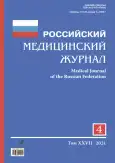The use of hyperbaric oxygenation in neurological practice
- Authors: Damulin I.V.1
-
Affiliations:
- Moscow Research Institute of Psychiatry — Branch of the V.P. Serbsky National Medical Research Centre for Psychiatry and Narcology
- Issue: Vol 27, No 4 (2021)
- Pages: 385-393
- Section: Reviews
- Submitted: 14.04.2022
- Accepted: 14.04.2022
- Published: 15.07.2021
- URL: https://medjrf.com/0869-2106/article/view/106282
- DOI: https://doi.org/10.17816/0869-2106-2021-27-4-385-393
- ID: 106282
Cite item
Abstract
Hyperbaric oxygenation (HBO) is traditionally considered a widespread additional method of therapy for various diseases that are associated with impaired tissue metabolism. Its use in neurological diseases of various origins is based on the significance of cerebral hypoxia as one of the leading pathogenetic factors. HBO increases blood oxygenation, which intensifies redox processes in tissues, improves cellular metabolism, decreases cerebral edema and intracranial pressure, and, ultimately, improves treatment results for neurological diseases of various pathogenesis. The use of HBO can form highly active oxygen compounds, some of which have antiviral activity. Therefore, taking the increased tissue oxygenation into account, HBO is considered a very promising treatment method for patients with coronavirus disease-2019.
HBO is recommended for carbon monoxide poisoning, stroke and poststroke disorders, dementia (including vascular dementia), and craniocerebral injury, as well as in craniocerebral injury consequences and benign intracranial hypertension. The results of using this method for headaches of vascular origin, polyneuropathies of various origins (including diabetic polyneuropathy), multiple sclerosis, and infantile cerebral palsy are less conclusive.
The existing contradictory opinions regarding the HBO protocol and the indications for the use of this treatment method require further research in this field.
Keywords
Full Text
About the authors
Igor’ V. Damulin
Moscow Research Institute of Psychiatry — Branch of the V.P. Serbsky National Medical Research Centre for Psychiatry and Narcology
Author for correspondence.
Email: damulin_igor@mail.ru
ORCID iD: 0000-0003-4826-5537
MD, Dr. Sci. (Med.), Professor
Russian Federation, MoscowReferences
- Calvert JW, Cahill J, Zhang JH. Hyperbaric oxygen and cerebral physiology. Neurol Res. 2007;29(2):132–141. doi: 10.1179/016164107X174156
- Choudhury R. Hypoxia and hyperbaric oxygen therapy: a review. Int J Gen Med. 2018;11:431–442. doi: 10.2147/IJGM.S172460
- Drenjančević I. Introductory Chapter: Hyperbaric Oxygen Treatment: Old Treatment with New Understanding. In: Hyperbaric Oxygen Treatment in Research and Clinical Practice – Mechanisms of Action in Focus. IntechOpen; 2018:1–8. doi: 10.5772/intechopen.79866
- Jain KK. The Handbook of Neuroprotection. Second Edition. Springer Science, Human Press; 2019. doi: 10.1007/978-1-4939-9465-6
- McDonagh MS. Hyperbaric oxygen therapy in cerebral palsy. In: Cerebral Palsy. Ch.27. Springer International Publishing; 2018:283–293. doi: 10.1007/978-3-319-67858-0_27
- Jain KK. The Use of HBO in Treating Neurological Disorders. In: Textbook of Hyperbaric Medicine. Sixth Edition. Springer International Publishing; 2017:221–236. doi: 10.1007/978-3-319-47140-2_18
- Gunes AE. Toxic Effects of Hyperbaric Conditions. In: Hyperbaric Oxygen Treatment in Research and Clinical Practice – Mechanisms of Action in Focus. IntechOpen; 2018:109–120. doi: 10.5772/intechopen.78392
- Baugh MA. HIV: reactive oxygen species, enveloped viruses and hyperbaric oxygen. Med Hypotheses. 2000;55(3):232–238. doi: 10.1054/mehy.2000.1048
- Kuffler DP. Hyperbaric oxygen therapy: an overview. J Wound Care. 2010;19(2):77–79. doi: 10.12968/jowc.2010.19.2.46970
- Wilson DF, Matschinsky FM. Hyperbaric oxygen toxicity in brain: A case of hyperoxia induced hypoglycemic brain syndrome. Med Hypotheses. 2019;132:109375. doi: 10.1016/j.mehy.2019.109375
- Gul F, Boran OF, Arslantas R. Microcirculation and Hyperbaric Oxygen Treatment. In: Hyperbaric Oxygen Treatment in Research and Clinical Practice – Mechanisms of Action in Focus. IntechOpen: 2018. P. 47–66. doi: 10.5772/intechopen.75609
- Cardenas DP, Muir ER, Huang S, et al. Functional MRI during hyperbaric oxygen: Effects of oxygen on neurovascular coupling and BOLD fMRI signals. Neuroimage. 2015;119:382–389. doi: 10.1016/j.neuroimage.2015.06.082
- Cardenas DP, Muir ER, Duong TQ. MRI of cerebral blood flow under hyperbaric conditions in rats. NMR Biomed. 2016;29(7):961–968. doi: 10.1002/nbm.3555
- Micarelli A, Jacobsson H, Larsson SA, et al. Neurobiological insight into hyperbaric hyperoxia. Acta Physiol (Oxf). 2013;209(1):69–76. doi: 10.1111/apha.12116
- Uszler JM. Neurophysiologic SPECT Brain Function Imaging and Hyperbaric Oxygen Therapy. In: Textbook of Hyperbaric Medicine. Springer International Publishing AG, 2017:91–97. doi: 10.1007/978-3-319-47140-2_10
- Mathieu D, Marroni A, Kot J. Tenth European Consensus Conference on Hyperbaric Medicine: recommendations for accepted and non-accepted clinical indications and practice of hyperbaric oxygen treatment. Diving Hyperb Med. 2017;47(1):24–32. doi: 10.28920/dhm47.1.24-32
- De Maio A, Hightower LE. COVID-19, acute respiratory distress syndrome (ARDS), and hyperbaric oxygen therapy (HBOT): what is the link? Cell Stress Chaperones. 2020;25(5):717–720. doi: 10.1007/s12192-020-01121-0
- Geier MR, Geier DA. Respiratory conditions in coronavirus disease 2019 (COVID-19): Important considerations regarding novel treatment strategies to reduce mortality. Med Hypotheses. 2020;140:109760. doi: 10.1016/j.mehy.2020.109760
- Thibodeaux K, Speyrer M, Raza A, et al. Hyperbaric oxygen therapy in preventing mechanical ventilation in COVID-19 patients: a re trospective case series. J Wound Care. 2020;29(Sup5a):S4–S8. doi: 10.12968/jowc.2020.29.Sup5a.S4
- Jain KK. HBO Therapy in Miscellaneous Neurological Disorders. In: Textbook of Hyperbaric Medicine. Sixth Edition. Springer International Publishing; 2017:365–370. doi: 10.1007/978-3-319-47140-2_24
- Shapira R, Solomon B, Efrati S, et al. Hyperbaric oxygen therapy ameliorates pathophysiology of 3xTg-AD mouse model by attenuating neuroinflammation. Neurobiol Aging. 2018;62:105–119. doi: 10.1016/j.neurobiolaging.2017.10.007
- Essex C. Hyperbaric oxygen and cerebral palsy: no proven benefit and potentially harmful. Developmental Medicine & Child Neurology. 2007;45(3):213–215. doi: 10.1111/j.1469-8749.2003.tb00934.x
- Sonn J, Meirovithz E, Mayevsky A. Hyperbaric Hyperoxia and the Brain in Vivo: The Balance between Therapy and Toxicity. Advances in Biomedical Photonics and Imaging. 2008:217–222. doi: 10.1142/9789812832344_0042
- Eynan M, Biram A, Mullokandov M, et al. The transition from day-to-night activity is a risk factor for the development of CNS oxygen toxicity in the diurnal fat sand rat (Psammomys obesus). Chronobiol Int. 2017;34(5):578–586. doi: 10.1080/07420528.2017.1281822
- Koch AE, Kahler W, Wegner-Brose H, et al. Monitoring of CBFV and time characteristics of oxygen-induced acute CNS toxicity in humans. Eur J Neurol. 2008;15(7):746–748. doi: 10.1111/j.1468-1331.2008.02158.x
Supplementary files






